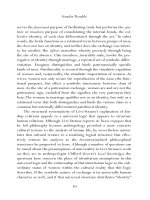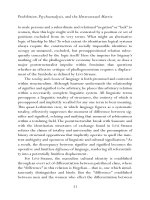GENDER TROUBLE 10
Bạn đang xem bản rút gọn của tài liệu. Xem và tải ngay bản đầy đủ của tài liệu tại đây (26.14 KB, 1 trang )
Preface 1999
one of cultural translation. Poststructuralist theory was brought to bear
on U.S. theories of gender and the political predicaments of feminism. If
in some of its guises, poststructuralism appears as a formalism, aloof
from questions of social context and political aim, that has not been the
case with its more recent American appropriations. Indeed, my point
was not to “apply” poststructuralism to feminism, but to subject those
theories to a specifically feminist reformulation.Whereas some defenders of poststructuralist formalism express dismay at the avowedly “thematic” orientation it receives in works such as Gender Trouble, the
critiques of poststructuralism within the cultural Left have expressed
strong skepticism toward the claim that anything politically progressive
can come of its premises. In both accounts, however, poststructuralism
is considered something unified, pure, and monolithic. In recent years,
however, that theory, or set of theories, has migrated into gender and
sexuality studies, postcolonial and race studies. It has lost the formalism
of its earlier instance and acquired a new and transplanted life in the
domain of cultural theory. There are continuing debates about whether
my own work or the work of Homi K. Bhabha, Gayatri Chakravorty
Spivak, or Slavoj Zˇizˇ ek belongs to cultural studies or critical theory, but
perhaps such questions simply show that the strong distinction between
the two enterprises has broken down.There will be theorists who claim
that all of the above belong to cultural studies, and there will be cultural
studies practitioners who define themselves against all manner of theory
(although not, significantly, Stuart Hall, one of the founders of cultural
studies in Britain). But both sides of the debate sometimes miss the
point that the face of theory has changed precisely through its cultural
appropriations. There is a new venue for theory, necessarily impure,
where it emerges in and as the very event of cultural translation.This is
not the displacement of theory by historicism, nor a simple historicization of theory that exposes the contingent limits of its more generalizable claims. It is, rather, the emergence of theory at the site where
cultural horizons meet, where the demand for translation is acute and
its promise of success, uncertain.
ix









